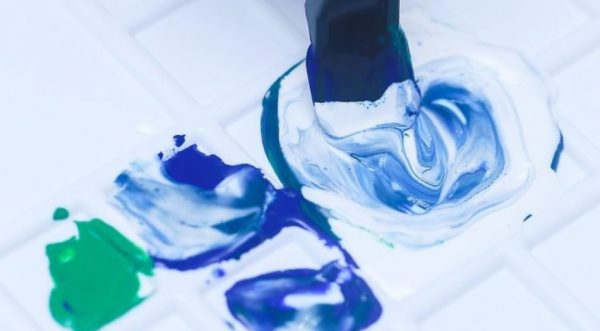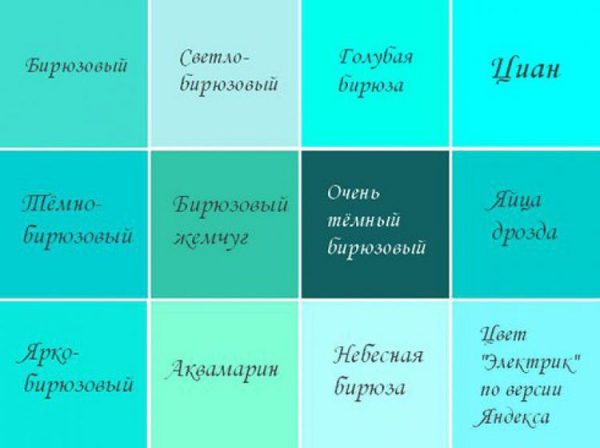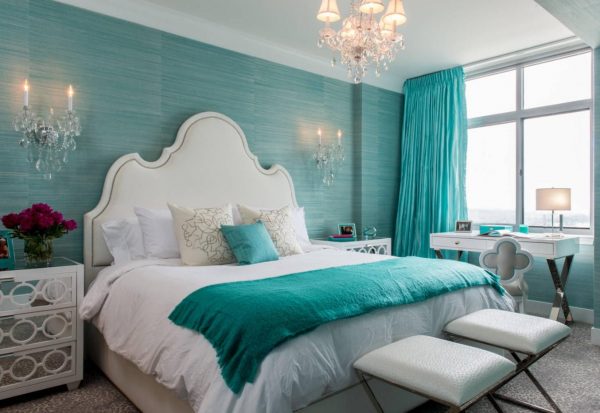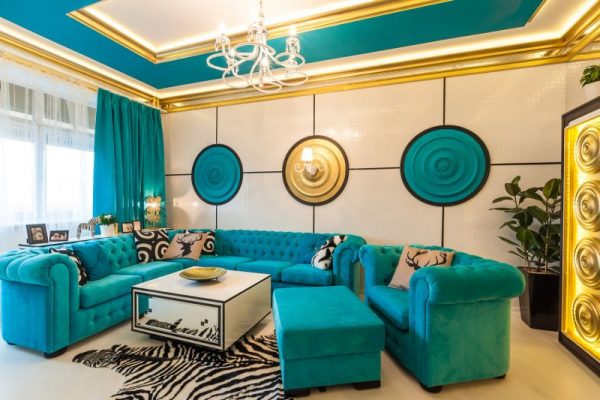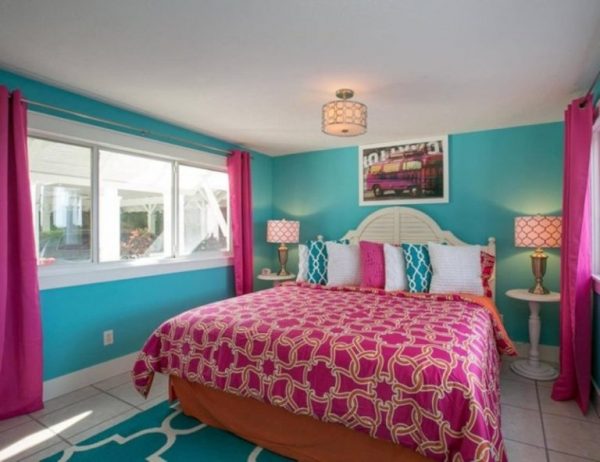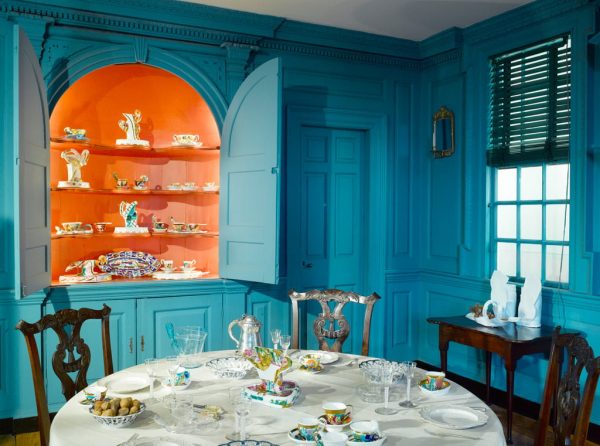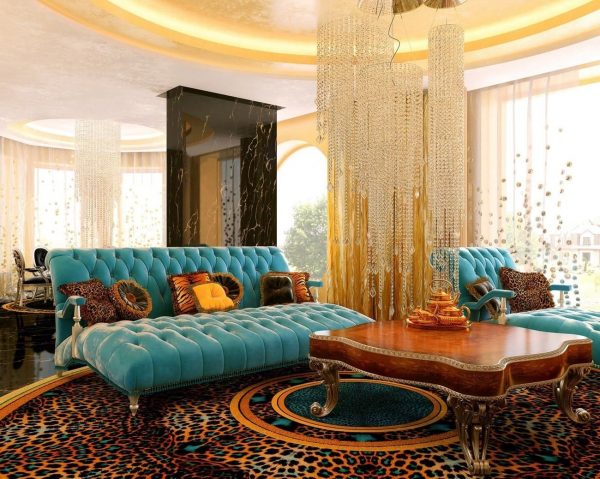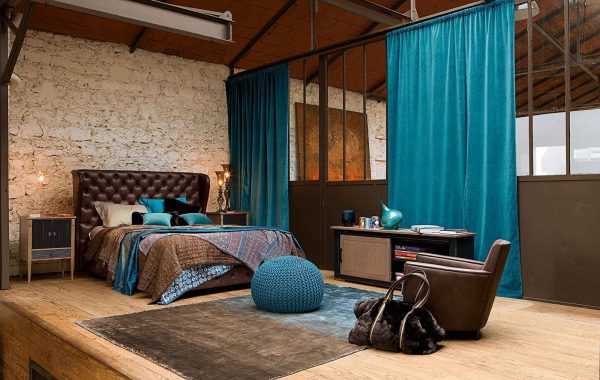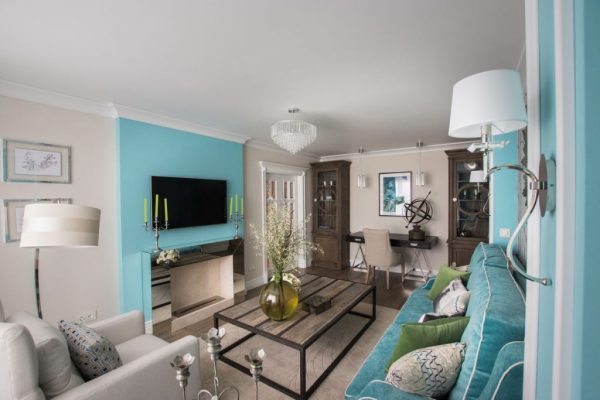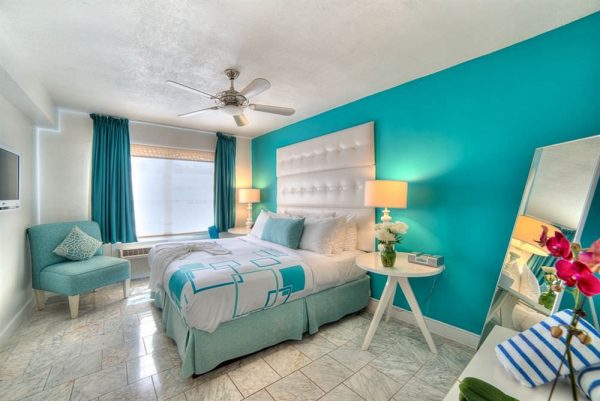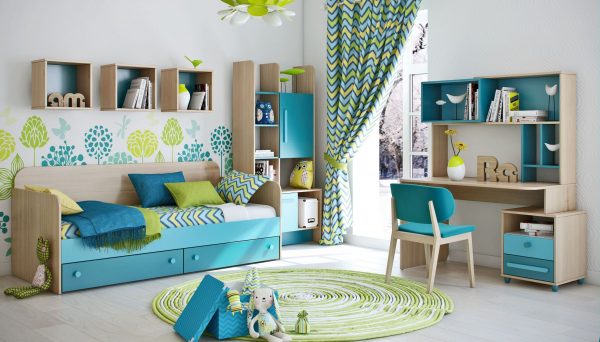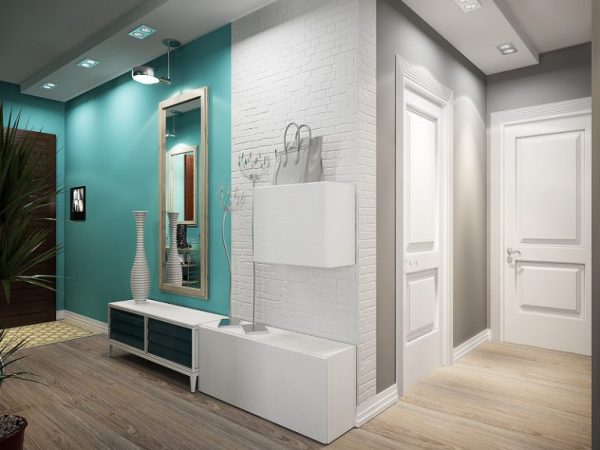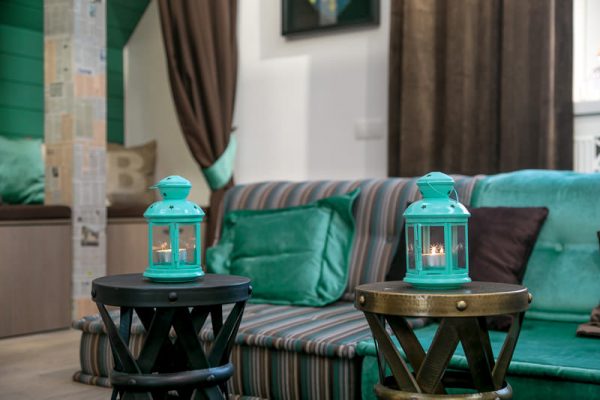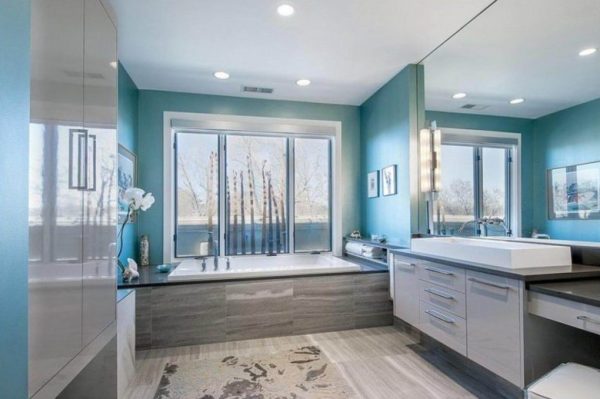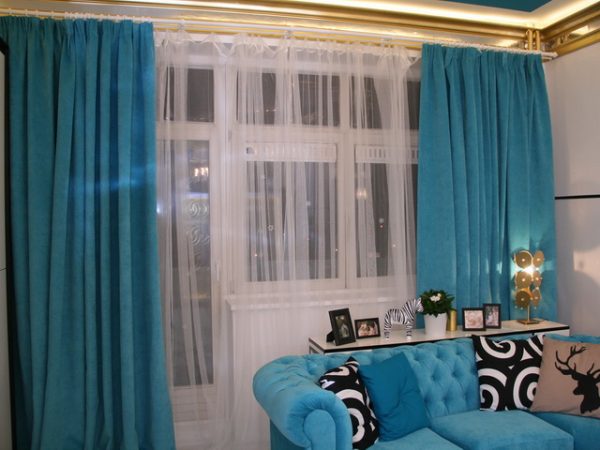The turquoise color in the interior is considered universal. It goes well with other popular shades, suitable for any room, can be used as a base or accent, and is also used in different interior styles. The high adaptability of the color is explained by the fact that it includes two tones (green and blue), which in themselves are perfectly combined with most famous shades.
- Description of color and methods for its preparation
- Shades of turquoise
- A combination of turquoise with other colors.
- White
- Gray
- The black
- Chocolate
- Gold and silver
- Purple
- Blue
- Pink
- Yellow
- Beige
- Orange
- Turquoise in different interior styles
- Classical
- Rustic
- Ethnic
- Art style
- Country
- Loft
- Nautical
- The inclusion of turquoise in the interior: recommendations and examples
- Living room
- Bedroom
- Kitchen
- Children
- Bathroom
- Hallway / hallway
- Accessories
- Finishing - walls, floor and ceiling
- Wall decoration
- Floor and ceiling finishes
- Turquoise accents
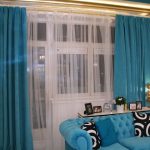
Description of color and methods for its preparation
Turquoise - color, surprising and attractive at the same time. Even in antiquity, it symbolized purity, purity, eternal love. It is believed that turquoise brings creative inspiration, eliminates mental anguish, reflects sensuality and emotional openness.
According to Feng Shui, the definition of color is somewhat different: turquoise is a symbol of wealth, luxury, attracts good luck and success in everything. Of course, few people think about the mystical meaning of this shade, but many prefer it in the interior. Turquoise - a bright, catchy color, while not vulgar. From him, as from a cold shade, comes a pleasant "Pacific" coolness, freshness. According to psychologists, color favorably affects a person’s mental state, relieves fatigue, irritation, and eliminates overstrain.
to contents ↑In the hue palette, turquoise is located between blue and green, it has many variations - from pastel to bright. You can make a turquoise color yourself. To do this, just take green and add a drop of dark blue to it. By mixing the paint, you can leave it as is or lighten it with white. The resulting material is suitable for painting walls and other surfaces, but previously it is recommended to test it on white paper.
Shades of turquoise
The tables for artists and decorators describe many shades of turquoise, which sometimes have the most incredible names. Of the colors that are used in interior design and are distinguished by good compatibility with other shades, the following are distinguished:
- Sky blue. The color is bright, exciting, it is used for fragmentary painting of walls, as well as for emphasizing individual zones in the room. This shade can have curtains, carpet, armchair, pouf, paintings, accessories. It is popular in the kitchen, living room, bathroom.
- Turquoise pastel. Very soft, soothing color. It is recommended for wallpaper, paint for basic wall decoration. It is used as a background for brighter, darker elements; it can be present in the decor of a bedroom, living room, and nursery.
- Bluish green (sea wave). This is a deep shade that will become the basis for the walls in the kitchen, in the hallway.In his office, with his help, they make beautiful accents.
The choice of a particular shade depends on the intended combination of colors in a particular room, and also takes into account the stylistic direction of the design. In addition to those described, other shades of turquoise can be used:
- arabic blue;
- icy green;
- cockatoo;
- Bermudian;
- water green;
- shade of a waterfall;
- opal;
- dusty turquoise;
- dark turquoise;
- aquamarine;
- Persian green
- mint turquoise, etc.
to contents ↑
A combination of turquoise with other colors.
Turquoise allows you to create interesting combinations with most shades of the spectrum. You can combine turquoise with light, dark and brightest tones.
White
The white and turquoise interior is the lightest, airy, refreshing, although in some cases it may seem too cold. If the windows of the room face north, it is recommended to introduce accents of yellow, green, mustard or red into the interior. The design, in which the walls and furniture are light, the textiles are turquoise, is very popular in bedrooms.
to contents ↑Gray
The living room will look good, where the walls are gray, and individual inserts or accessories are turquoise. For such an interior, both pastel and bright shades of turquoise are suitable, although there are certain recommendations depending on the style. For classics it is better to use dusty turquoise, for art deco - juicy tones of the sea wave. Light and medium turquoise shades are ideal for a Mediterranean-style living room.
The black
Combine with black the best lightest shades of turquoise. If the minimum is dark, the interior will look stylish, elegant. Of the good options for the accent use of black, one can note a vase on the floor, rug, chairs, candlesticks. When there is too much black, the room will appear gloomy.
Chocolate
Usually in different tones of brown make out floor coverings, furniture, doors. Chocolate, coffee brown, wenge - all these colors look harmoniously against the background of light turquoise walls. In large rooms, individual fragments of walls and even beams on the ceiling are made brown, combining with bright tones of turquoise. The colors of the sea wave can also be furniture: a sofa, armchairs, a bed with a soft headboard, a kitchen set, which against the background of the dark floor and light walls will look unusual and refreshing.
to contents ↑Gold and silver
The combination of turquoise shades with gold, silver details will provide the room with a luxurious but discreet look. Such a design technique in the classical style is especially popular. Against the background of turquoise walls, statuettes, furniture, doors, vases and lamps of “precious” colors will look great.
to contents ↑Purple
The combination of turquoise with violet is used to create a mysterious, fantasy, magical atmosphere. In large volumes, dark purple is tiring, so you can use lilac instead. Typically, designers use such combinations in the design of a nursery, a hall or a bedroom in an Arabic (oriental) style. Lavender shades are also compatible with turquoise, such duets are suitable for modern minimalist interiors and rooms in a vintage style.
to contents ↑Blue
The combination of related shades gives a feeling of coolness, freshness, airiness. The blue-turquoise range is ideal for rooms in a marine and Mediterranean style. It is usually used in bedrooms and living rooms.
Pink
The only option for combining pink and turquoise may be to complement the aqua background with separate accents of light pink, beige pink, dusty rose. If pink is too bright, the combination will be intrusive. It is best to use pink tones in textiles, ornament, decor, accessories.
to contents ↑Yellow
Both tones - both yellow and turquoise - are quite bright, so the combination may seem too contrasting. But with the right approach, a sunny shade will help to make the interior joyful, optimistic, which is perfect for a nursery or living room.Both colors in the duo should be muted, while turquoise is taken as the background, and yellow or lime - in the form of accents. Gray or milk, cream color will complement the picture - they will visually “unload” the room.
to contents ↑Beige
The combination of beige and turquoise is one of the most popular and successful. It is suitable for decorating a room in a Mediterranean style, as it resembles sand and sea water. It is best to make the walls beige and shade them with curtains, furniture, accessories in turquoise color.
Orange
Turquoise goes well with warm shades - brick, orange, sand, terracotta. Typically, to give the interior a stylish, expressive enough introduction of small bright impregnations in the form of souvenirs, accessories, upholstery or ornaments on furniture.
to contents ↑Turquoise in different interior styles
Shades of turquoise are used in a variety of interior styles, which only confirms their versatility and attractiveness.
Classical
If the room corresponds to the classical design and contains turquoise elements of decoration, it will resemble the hall of an ancient palace. In addition to background wall decoration, turquoise color may be present in the picture of wallpaper, tulle, curtains, furniture. Gold and silver in small details complement the classic interior.
to contents ↑Rustic
In a rustic style, the color of the sea wave can have an accent value. Usually the floor, ceiling, walls are decorated in a neutral range, and curtains, carpets, paintings, furniture can be made turquoise.
Ethnic
Popular in the ethno style are upholstered furniture, hanging canopies and lamps, folding decorative pillows of turquoise color. This shade may be predominant in the textile products of the bedroom, living room, especially in the Chinese style. A good combination of colors will also be turquoise with yellow-green.
Art style
This type of design involves mixing a variety of shades that may initially seem difficult to perceive. For example, in this direction, it is considered normal to add small black or brown details to the main turquoise background.
to contents ↑Country
Country style involves a combination of "natural" shades - green, blue, gray, brown. Turquoise also fits perfectly into such a gamut, it is only important that all colors are combined in the overall picture and not contradict each other. Coloring with polka dots, a cage, animal images and floral motifs look advantageous in country.
Loft
In the loft, “brutal” colors are traditionally used - brick, chocolate, gray, steel. They can be quite diluted with both bright and modest shades of turquoise in the form of separate accents. Examples include paintings, panels, frescoes in the hallway, chairs and blinds in the kitchen, the decoration of the upper cabinets in the bathroom, textiles in the living room and bedroom.
to contents ↑Nautical
Previously, in the marine style, houses were usually decorated, now it is increasingly being used to equip urban apartments. The interior involves the use of blue, turquoise, white and brown tones. Moreover, the blue gamut can have absolutely any shade. White is used in its pure form, cream and milk tones are also popular.
The inclusion of turquoise in the interior: recommendations and examples
The versatility of shades of turquoise color allows you to design any room for them - from the kitchen to the bathroom. Depending on the type of premises, the rules for the use of turquoise in decoration can vary. Typically, designers are guided by the motto: “Turquoise loves harmony”, while advising “peep” the beautiful color combinations of nature itself.
Living room
The central room in the house may well be decorated with rich shades of turquoise - this will give it a "royal" look. It is important only to choose the right color-companions, so that the overall appearance is harmonious. For the living room, white, blue tones, the colors of natural wood are well suited. Turquoise is successfully combined with brickwork, cork coverings, light marble.
If the walls are papered, it is better if they have a large ornament. Light gray or beige walls with a turquoise and yellow pattern will be a good option. The ensemble is complemented by turquoise curtains, a plaid and pillows on the sofa. The living room also looks interesting, in which one wall is turquoise, and the rest are light or yellow, green. You can add a couple of brown accents, it is only important that their number be moderate (up to 10-15%).
to contents ↑Bedroom
The bedroom can be made a “branch” of the sea resort: for this you just need to add a few turquoise accents or use light wallpaper in the color of the sea wave. Wall coverings can be plain or with an unobtrusive ornament. The pattern can be gray-green, yellow, light orange, dark blue - as desired.
A good option is the use of snow-white curtains that will revive the overall turquoise image and remind you of sea foam. Of the fabrics, light materials are best suited: silk, linen, cotton. White frames of paintings, panels, light furniture, figurines look great on the turquoise background of the walls.
to contents ↑Kitchen
In the kitchen, it is permissible to use bright, even flashy shades. It is important that it is light enough here, then the dark turquoise color will not cause a visual decrease in the room. With this shade, you can arrange a kitchen apron, furniture, curtains, blinds, appliances, dining group (of course, not all at once). It is desirable to make the ceiling and walls light, only a gentle turquoise tone is allowed. For decoration, it is worth using wallpaper or textured plaster. For a change, shades of brown, yellow or green are added to the interior.
to contents ↑Children
Turquoise is a universal color, it is suitable for girls and boys. The little princess will like the combination with lilac, the young gentleman - the combination with green. For any room, a duet with one of these colors is suitable:
- cream;
- white;
- creamy;
- beige;
- caramel;
- champagne color.
to contents ↑It is better not to use the dark turquoise palette, but to dwell on soft, delicate shades. Blue-green tones in the interior will help relieve stress, calm the child.
Bathroom
The sea in the bathroom is a great idea. Since it is rarely spacious here, too dark tones of turquoise should not be used. The ideal option is to choose light, azure shades that are in harmony with the white background. The tile can be gray, beige, light brown, while the color of turquoise is given to textiles, mirror frames, bath curtains, and a laundry basket.
Hallway / hallway
This room creates the first impression of the house, apartment, so its design needs to be paid more attention. An excellent solution for the corridor will be the use of cheerful turquoise. If the hallway is small, use light shades of the sea wave in combination with white or beige details.
to contents ↑Accessories
Decor plays a crucial role in interior decoration. For the living room, bedroom accessories are mandatory, and you can apply another 1-2 colors for the scenery. Successful options for accessories will be:
- candlesticks;
- vases;
- pictures;
- figurines;
- Posters
- textile;
- carpets.
The best colors for the decor of "turquoise interiors" are brown, black, silver, gold, as well as yellow, blue and green.
to contents ↑Finishing - walls, floor and ceiling
When carrying out finishing work, you need to take into account the correct combination of colors, as well as textures and materials, only in this case the interior will look harmonious.
Wall decoration
The easiest way is to cover the walls with wallpaper in turquoise color. In general, the coating material can be any, paint is often used, although for convenience it loses to wallpaper.Despite the possibility of tinting in absolutely any color, the paint will not hide wall defects, moreover, it will be quite difficult to apply a drawing or ornament to it.
Wallpaper can already have a sophisticated decor that you like, which will give an individual style and help zoning the space. You can also use your favorite photo wallpaper on one wall, and plain coatings on the rest, this design technique is very popular. The darker the color, the more it will hide the space, this should also be remembered.
For the bathroom, tiles of a turquoise hue are used. It goes well with white, other light colors. The turquoise floor in a duet with white walls that are decorated with panels with blue-green images will look stylish. The exact shade should also depend on the size of the room and, if possible, be lighter.
to contents ↑Floor and ceiling finishes
Traditionally, the ceiling is painted white, it will be in harmony with the freshness of the turquoise walls. But in some styles, it is appropriate to use a stretch ceiling with turquoise elements or create multi-level structures with beams, where the marine shade is also involved. The colored floor is an equally interesting solution. Tile, carpet, as well as a carpet with a beautiful pattern that will elegantly fit into classic style, country, vintage and many other areas can become a covering.
to contents ↑Turquoise accents
If you want to refresh the interior of the room, some elements of turquoise color will help in this. For example, curtains in combination with other textile details are ideal, they will make the room cheerful and give a feeling of proximity to the sea. You do not have to buy turquoise furniture. It is much easier to put beautiful wraps on chairs, on a plaid sofa or pillows, and turquoise will attract attention, decorate the interior. This magical color has many advantages, the main of which is attractiveness and compatibility with most interior tones, which designers have successfully used.

